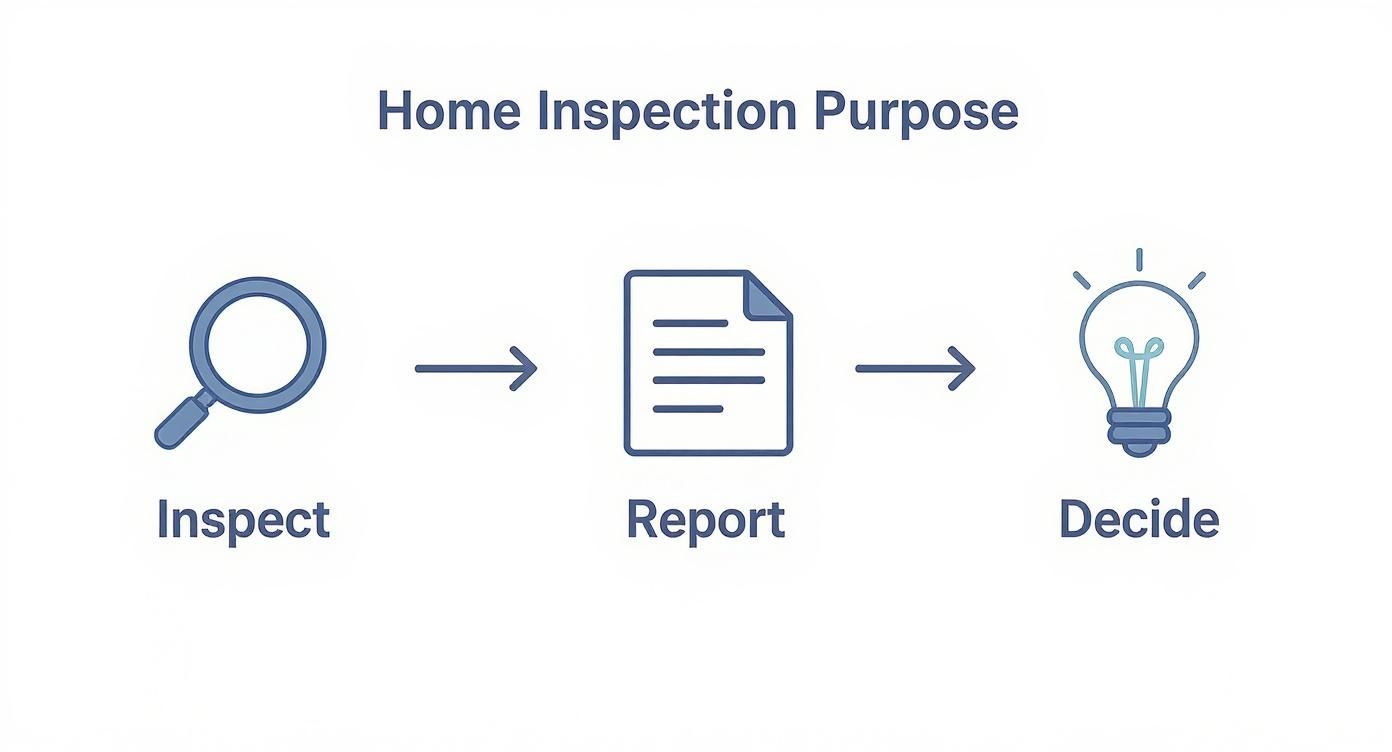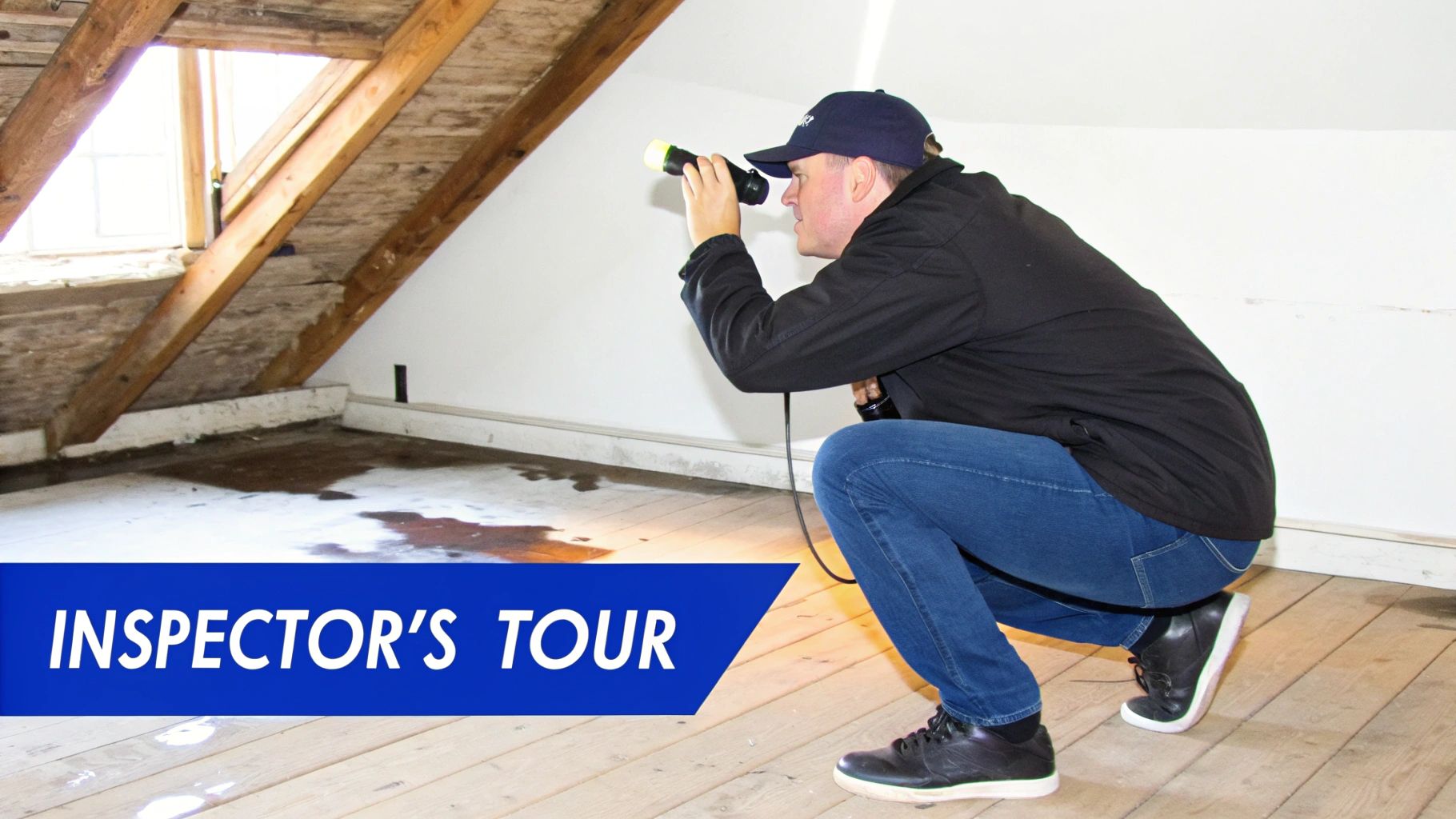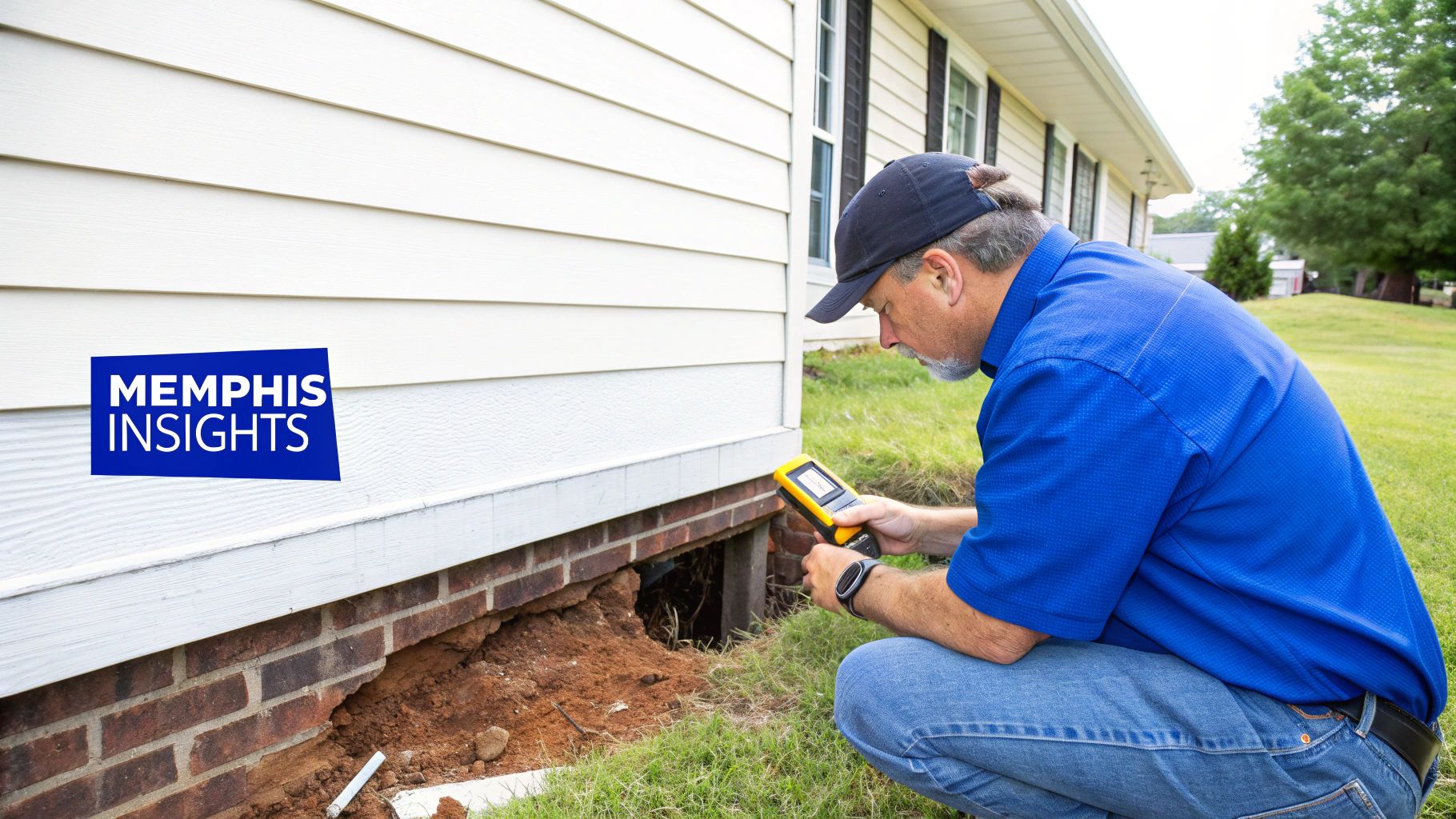So, what exactly is a home inspection?
Think of it like getting a full physical for a house. It's a top-to-bottom, non-invasive visual check-up of a property's condition, giving you a detailed report card on all its major systems and parts. It's an absolutely critical step in the home-buying process, designed to uncover any existing problems—or potential ones lurking just out of sight—before you sign on the dotted line.
It’s not a pass-or-fail exam. Instead, it’s an objective, professional look at the home’s overall health.
What a Home Inspection Really Means for You
Just like a doctor checks a patient's vital signs, a home inspector dives into a property's core systems. We look at everything from the foundation holding it up to the shingles keeping it dry, all to identify the home’s current condition and spot any underlying issues. The goal is simple: to give you a clear, unbiased picture of the investment you’re about to make.
This isn't just a "nice-to-have"; it's a fundamental part of how real estate works in America. The building inspection industry is huge, generating around $5.0 billion in annual revenue as of 2025, and home inspections are the biggest piece of that pie. That number alone shows just how vital this service is for protecting buyers like you.
From Examination to Empowerment
The whole inspection process is designed to put you in the driver's seat. It can really be broken down into three stages that give you the power to make a smart decision.
This flowchart shows how an inspection turns uncertainty into a confident choice.

This journey from inspection to decision arms you with the hard facts you need to move forward. For instance, getting a comprehensive roof inspection gives you the details on its condition, common issues for its age, and potential costs.
With this kind of knowledge in hand, you can:
- Make an informed decision based on a real understanding of the home's condition.
- Negotiate repairs or credits with the seller for any issues we uncover.
- Budget for future maintenance because you'll know the age and shape of major systems.
- Confidently walk away if the problems are just too big or expensive to take on.
Ultimately, a home inspection is your single best tool for gaining clarity and confidence before making one of the biggest financial commitments of your life.
Home Inspection at a Glance: What It Is vs. What It Isn't
It's easy to have misconceptions about what a home inspector does (and doesn't do). This quick table breaks it down to set the record straight.
| Aspect | What It IS | What It Is NOT |
|---|---|---|
| Purpose | An objective visual assessment of the home’s condition on inspection day. | A guarantee of future condition or a pass/fail test. |
| Scope | A non-invasive check of accessible major systems and components. | An exhaustive, destructive investigation (we don't open walls). |
| Outcome | A detailed report identifying defects and potential concerns. | An appraisal of the home's value or a code compliance inspection. |
| Focus | Functionality, safety, and significant defects that could be costly. | Cosmetic issues like peeling paint or scuffed floors. |
| Expertise | A generalist evaluation of the entire property. | A specialized analysis (like engineering, pest, or mold testing). |
So, while we can't predict the future or see through solid walls, a professional inspection gives you an incredibly powerful snapshot of the home’s current reality. This information is your leverage and your peace of mind, all rolled into one.
A Guided Tour of What Inspectors Look For
A home inspection is much more than a simple walkthrough with a checklist. It’s a systematic investigation into the health, safety, and overall condition of a property. Think of an inspector as a detective—we’re trained to spot clues that an untrained eye would easily miss.
That small water stain on the ceiling? It isn't just a cosmetic flaw. It could be a sign of a slow leak in the roof or a hidden plumbing issue from the bathroom upstairs. We see the house as an interconnected system, and our goal is to understand how each major component works on its own and as part of the whole.
This guided tour will walk you through exactly what a professional inspector examines, from the outside in.

The Exterior Shell
The inspection starts before we even step through the front door. A home's exterior is its first line of defense against the elements, so its condition tells us a lot and sets the stage for what we might find inside.
Our exterior check includes:
- Roofing: We’re looking for damaged, missing, or aging shingles, signs of shoddy installation, and the condition of flashing around chimneys and vents where leaks often start.
- Siding and Trim: We check for cracks, decay, or damage in the siding. Any of these can create an opening for water to penetrate the home's structure.
- Grading and Drainage: Is the ground sloped away from the house? This is critical. We look for areas where water might pool against the foundation, a common cause of moisture problems.
The Structural Bones
Next, we move to the home’s core: the foundation and framing that hold everything together. Problems here can be among the most expensive to fix, making this a non-negotiable part of the process.
We assess the foundation for signs of stress, like significant cracks, settling, or bowing walls. In homes with a crawl space or basement, we’ll get into those areas for a closer look at the support system, searching for moisture, wood decay, or signs of unwanted pests.
A home inspection is intended to assist in evaluation of the overall condition of the dwelling. It is based on observation of the visible and apparent condition of the structure and its components on the date of inspection.
This principle is key. We report on what we can see and safely access, giving you a snapshot of the home’s condition on that specific day.
The Home's Major Systems
Inside, our focus shifts to the complex systems that make a house functional and comfortable. These are the mechanical and utility workhorses you rely on every single day.
Electrical System
The electrical system is all about safety. We start at the main panel, checking for proper wiring, ensuring the amperage is adequate for the home's needs, and spotting potential fire hazards like outdated wiring or overloaded circuits. We then test a representative number of outlets and switches throughout the home to make sure they work and are properly grounded.
Plumbing System
With plumbing, we're on the hunt for both active leaks and evidence of past water damage. We run faucets, flush toilets, and check under sinks to test water pressure and drainage. We also identify the type of pipes used and inspect the water heater for its age, condition, and proper installation.
HVAC System
Your heating, ventilation, and air conditioning (HVAC) system is one of the most expensive components in any home. We identify its age and type, then operate it in both heating and cooling modes (weather permitting) to confirm it’s working. The inspection includes a thorough look at the ductwork to identify any serious issues, like signs of blocked air ducts that hurt efficiency and airflow.
The Interior Living Spaces
Finally, we move through the interior rooms, tying all our observations together. We operate windows and doors, check for functional smoke detectors, and look for evidence that confirms issues we may have suspected elsewhere.
That stain on the ceiling below a bathroom? It could connect the dots to a suspected plumbing leak. This is where the detective work pays off, linking clues from different parts of the house to build a complete picture for your report.
Understanding Different Types of Home Inspections
Just like you wouldn’t see a cardiologist for a sprained ankle, you need the right kind of inspection for your specific property situation. Most people have heard of the standard buyer's inspection, but that's just one piece of the puzzle. There are several other types, each designed to give you the exact information you need, right when you need it.
Knowing the difference is crucial. It ensures you’re not just getting an inspection, but the right one for your goals, whether you’re buying, selling, or just maintaining your home.
Common Inspection Types
The one everyone knows is the Buyer's Pre-Purchase Inspection. This is the classic, top-to-bottom check-up a home buyer gets after their offer is accepted but before the deal is final. It’s your single best tool for uncovering hidden issues and gives you powerful leverage for negotiating repairs.
But what if you're the one selling? More and more homeowners are getting a Seller's Pre-Listing Inspection. This is a smart, proactive move that lets you find and fix problems before your house ever hits the market. In a real estate market that's always changing, this strategy is becoming a game-changer. As market forecasts point toward a more balanced playing field, a pre-listing inspection can help you justify your asking price and build immediate trust with potential buyers. For more on this, check out our insights on how market trends are shaping home inspections.
Other key inspection types you might encounter include:
- 11-Month Builder's Warranty Inspection: If you bought a new construction home, this inspection is performed just before the builder's one-year warranty runs out. It’s your last chance to find defects the builder is still on the hook to fix.
- Annual Maintenance Inspection: Think of this as a yearly physical for your home. It helps current homeowners catch small issues before they snowball into expensive repairs, protecting their biggest investment.
- Commercial Property Inspection: This is a whole different ballgame. It's a far more complex assessment for business properties, focusing on things like ADA compliance, commercial-grade systems, and different safety standards.
Specialized Testing Beyond the Standard Scope
A standard home inspection gives you a fantastic, high-level view of a property's condition, but it can't see everything. It's a generalist's report, not a specialist's deep dive. Certain hazards are invisible to the naked eye and require specific tools and expertise to uncover.
These are known as ancillary or specialized inspections, and they can usually be added to a standard inspection for an additional fee. Think of them as ordering specific lab tests after a general check-up. They target hidden threats that a visual-only assessment would miss.
A standard home inspection is based on observation of the visible and apparent condition of the structure and its components on the date of inspection. It is not intended to reveal latent or concealed defects.
This is a critical distinction to understand. To get the full story on a property, especially in a place like Memphis with its own unique environmental factors, you may need to dig deeper with a few targeted tests.
Some of the most common specialized services we offer include:
- Mold Testing: Absolutely essential in our humid climate. This involves taking air and surface samples to identify the presence and type of harmful mold spores.
- Radon Testing: Radon is a naturally occurring radioactive gas that you can't see, smell, or taste. It’s a leading cause of lung cancer, and testing is the only way to know if your home has dangerous levels.
- Sewer Scope: We run a specialized camera through the home's main sewer line to find nasty surprises like cracks, collapses, or invasive tree roots before they cause a messy and expensive backup.
- Termite and Pest Inspection: This inspection looks for the tell-tale signs of wood-destroying insects and other pests that could be silently damaging the home's structure.
How to Read Your Home Inspection Report
Getting a 50-page technical document packed with photos and notes can feel a bit overwhelming at first. But trust me, that home inspection report is the single most powerful tool you have in your negotiation toolkit. Learning to read it the right way turns a dense document into a clear, actionable roadmap for what comes next.
Think of it like a doctor's chart for your potential new home. Some findings are like a "critical diagnosis"—a major crack in the foundation or an ancient electrical panel—that need a specialist's attention right away. Others are more like a "common cold," such as a drippy faucet or a window that sticks. Those are minor issues you can likely tackle over time. Your job is to understand the difference.

Start With the Summary
There’s a reason most modern reports kick off with a summary. This is your 30,000-foot view, highlighting the most significant defects or safety concerns we found during the inspection. Focus here first. It helps you grasp the big-picture issues that will probably drive your repair requests and negotiations.
Don't stop there, though. The real value is buried in the details that follow, where you’ll find photos and specific descriptions for every single issue. The context in the main body of the report is what helps you understand why something is a problem.
Focus on High-Priority Issues
As you dig in, it helps to categorize what you’re seeing. Your inspector will often do this for you, but it’s smart to think in these terms:
- Major Defects: These are the big-ticket items. We're talking about structural problems, a failing roof, or an HVAC system on its last legs. These are your absolute top priorities for any negotiation.
- Safety Hazards: Anything that poses a risk falls right into this bucket. Think exposed wiring, a lack of GFCI outlets near sinks and tubs, or improper venting for a gas appliance.
- Minor Repairs and Maintenance: This covers things like loose doorknobs, cracked window panes, or systems that are just getting close to the end of their expected lifespan. These are great to know for future budgeting but probably aren't deal-breakers.
A great report doesn't just list problems; it provides context. It explains the potential consequences of a defect and recommends the appropriate next step, whether that's monitoring, repair, or further evaluation by a specialist.
Technology is also making modern reports far more insightful. Things like thermal imaging can spot hidden energy leaks or missing insulation that the naked eye would completely miss, giving you a much deeper understanding of the home's true condition. You can learn more about how the future of home inspection technology is changing the game and making your report more valuable than ever.
Navigating Home Inspections in the Memphis Area
Every part of the country has its own unique quirks when it comes to homes, and the Memphis area is certainly no exception. A standard home inspection is a great tool, but it becomes infinitely more valuable when the inspector knows our local landscape inside and out. What works for a house in a dry, desert climate just doesn't cut it here in West Tennessee.
The combination of our famous humidity and a large number of older homes creates a very specific set of problems we see time and time again. An inspector with deep local roots knows exactly what to look for, turning a general check-up into a focused hunt for regional risks. This is where a real understanding of our climate and building history makes all the difference.

Common Issues in West Tennessee Homes
An inspector from out of town might walk right past subtle clues that a local pro will catch in a heartbeat. Around Memphis and West Tennessee, we’re constantly dealing with issues tied directly to our environment.
Here are a few of the big ones:
- Crawl Space Moisture: Our humid climate is brutal on crawl spaces. Without proper ventilation, you get condensation, which can lead to wood rot and moisture seeping into the foundation. Over time, this can seriously compromise a home’s structure.
- High Humidity and Mold: That persistent dampness is the perfect recipe for mold. A local inspector knows all the sneaky places it likes to hide—in basements, attics, and behind walls—where it can cause major health problems and require expensive remediation.
- Older Housing Stock Challenges: So many of our beautiful Memphis homes have been around for decades. They’ve got character, for sure, but they can also hide outdated electrical systems, aging plumbing, and original foundations that have settled and shifted over the years.
Local knowledge isn't just a nice-to-have; it's a necessity. An inspector who has seen these specific regional problems hundreds of times can spot potential disasters that others might easily overlook.
Choosing an inspector with deep roots in the community is your single best defense. A company like Upchurch Inspection brings more than just technical skill to the table; we bring a lifetime of experience with West Tennessee homes. We get the soil, we get the weather, and we get the unique construction styles that define our area. This specialized knowledge ensures your home inspection gives you a truly accurate picture of your investment, so you can move forward with confidence.
How Much Should I Budget for a Home Inspection?
It’s one of the first and most practical questions every home buyer asks: "So, how much is this going to cost?" While it's a critical part of your due diligence, the good news is that a home inspection is a tiny fraction of the home's total price. Think of it as a small investment that can save you thousands in unexpected repairs down the road.
Here in the Memphis and West Tennessee area, a standard home inspection for a typical single-family home usually lands somewhere between $400 and $600. But that’s not a hard-and-fast number. It’s more of a baseline that shifts depending on the specific property you’re looking at. Understanding what moves that number up or down will help you budget accurately and avoid any surprises.
What Influences the Final Price?
The final cost of your home inspection comes down to the property's unique characteristics. It’s pretty simple, really: a larger, more complex home just takes more time and effort to evaluate from top to bottom.
Here are the main things that will adjust your inspection fee:
- Home Size: Square footage is the single biggest driver of cost. A sprawling 4,000-square-foot home has a lot more ground to cover than a 1,500-square-foot condo, so the inspection will naturally cost more.
- Property Age: Older homes are full of character, but they also tend to have more complex systems, layers of past renovations, and the potential for age-related quirks that demand a more detailed investigation.
- Foundation Type: A home on a concrete slab is fairly straightforward to inspect. But one with a full crawl space or basement? That requires the inspector to gear up and navigate a tight, often dirty area to check for moisture, pests, and structural integrity.
- Additional Structures: Got a detached garage, a separate workshop, or a cute guest house on the property? These all add to the inspection time and will be factored into the overall cost.
The price reflects the time and expertise needed to do the job right. A rock-bottom price might seem tempting, but it could mean a rushed inspection—and that could cost you a fortune in the long run.
Adding specialized services will also affect your final tally. For instance, if you decide you need tests like mold sampling, radon testing, or a sewer scope, we’ll quote those as separate line items on top of the standard inspection fee. At Upchurch Inspection, our goal is total transparency. We provide a clear, detailed quote right from the start so you know exactly what to expect.
Got Questions? We've Got Answers.
Even after you've got the basics down, it’s natural to have a few more questions pop up. Getting straight answers is the best way to build the confidence you need for this major step. Let's dig into some of the most common questions we get from clients every day.
Can a House "Fail" an Inspection?
This is the number one question we hear, and the answer is a simple one: no. A home inspection isn't a pass-or-fail test.
Think of it more like a physical check-up for a house, not a final exam. Our job as inspectors is to give you an objective, unbiased look at the home's condition on the day we're there. The report highlights the good, the bad, and the "heads-up" issues—it doesn't give the house a grade. This information is purely for you, the buyer, so you know exactly what you're getting into.
Should I Actually Show Up for the Inspection?
Absolutely. While you don’t have to be there, we strongly encourage it, especially for the final walkthrough at the end. Being there in person is a learning opportunity that a written report just can't match.
By walking the property with your inspector, you can:
- See any issues with your own eyes, which adds a ton of helpful context.
- Ask questions on the spot to clear up anything you're unsure about.
- Learn where crucial things like the main water shut-off valve are located.
- Get a real sense of which problems are a big deal versus which are minor maintenance items.
This experience turns the report from a list of facts into a practical user manual for your potential new home.
What if the Inspector Finds a Major Problem?
Finding a significant issue doesn't automatically mean the deal is dead. Far from it. Instead, it just starts a conversation. If we uncover something major, you have a few ways to move forward:
- Negotiate for Repairs: You can ask the seller to have specific problems fixed before you close on the house.
- Ask for a Credit: Another popular option is to ask the seller for a credit at closing or a reduction in the sales price to help cover the cost of future repairs.
- Walk Away: If the problems are just too big or the seller won't budge, your inspection contingency gives you the power to back out of the contract and get your earnest money back.
When you're ready to move forward with a clear, detailed understanding of your next home, trust the local experts at Upchurch Inspection. Schedule your Memphis or West Tennessee home inspection today and buy with total confidence.
Article created using Outrank

